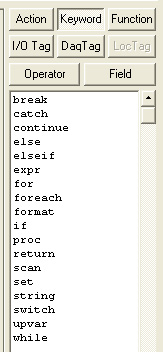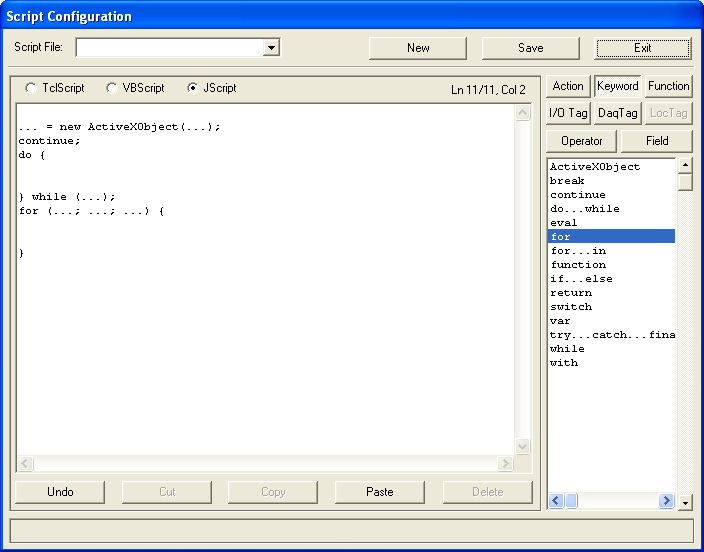
The components of a WebAccess Script are grouped into five Areas. These major components are grouped under “pushbuttons” in the Screen Script Editor and SCADA System Script Editor.

· ACTION – these are commands specific to WebAccess. They are usually similar to pushbutton keymacro commands. They address the need for scripts to interact with automation systems, real-time data, controls, IO and users. Examples include Alarm Acknowledge, GO TO a Graphic Display, Set a Value. ACTION commands enhance the standard Tcl, VB Script and Java script commands. The ACTION commands are essentially identical between all three scripting languages.
· KEYWORD - The keyword are the one of the three languages of WebAccess scripts: Tcl, VB Script or Java scrip. a scripting language commonly used for hardware-control programs. Tcl, VB Script and Java Script are open source language; you can find examples and tutorials on the Internet. They are taught at many colleges and universities. They are the If, THEN, ELSE of WebAccess. A typical WebAccess script will include both KEYWORD command and ACTION commands.
The Keywords change depending on which language you select for your script (a single script can only use one language).
If you select TCL, then select the Keyword button you see the most commonly used tcl commands listed in the pane on the right. Tcl is commonly pronounced as "tickle".

If you select VBScript, then select the Keyword button you see the most commonly used VB Script commands listed in the pane on the right.
![]()

If you select JScript, then select the Keyword button you see the most commonly used JAVA Script commands listed in the pane on the right. Tcl is commonly pronounced as "tickle".

Double-clicking on a command will insert the entire command into the script. You must add local tags, or other features for the command to actual execute (this is just a handy syntax guide). You could also type the command string.

Note - there are many more commands support in Tcl, VB Script and J Script than listed in the dialog box. See 12.5 Tcl KEYWORD commands (built-in Tcl) for a larger list of Tcl commands. See an on-line tutorial for all commands supported by Tcl, VB Script and J Script.
· FUNCTIONS – these are mostly the advanced arithmetic functions (sine, cosine, rounding, logarithmic functions)
· OPERATORS – are simpler math operators (multiply, divide, addition, greater than, equal to, etc) and grouping characters (parenthesis, square brackets etc.)
Additional components of WebAccess are the Tags (the real-time data) that WebAccess reads from Automation Equipment and internal tags describing WebAccess:
· IO TAGS – this is the real-time data collected from Automation Equipment such as PLCs, Controllers, VAVs, OPC Servers, etc. This also includes the globally available internal tags (Calculation Tags, Accumulation Tags and Constant Tags). Constant Tags are frequently used to display the results of script programs or enter data for use by scripts.
· FIELD – these are Fields associated with IO TAGS, for example description, High Span, Alarm Limits, Alarms States etc.
· Daq TAG – these are internal system tags that describe the state WebAccess , for example Serial Number, Last Button Pushed, communication port status.
· LOCAL TAG – These are user defined “screen tags” internal to WebAccess and commonly used for display animation or reformatting data before presentation. Local Tags are frequently used the results of script programs to display or enter data for use by scripts. This button will be "gray" and un-pickable if there is no Local Tag file assigned to the display.